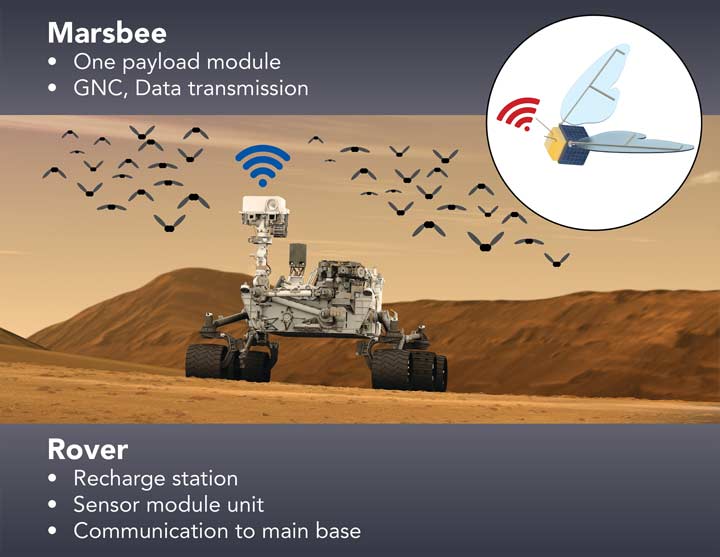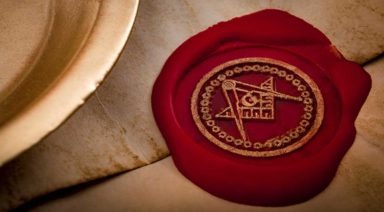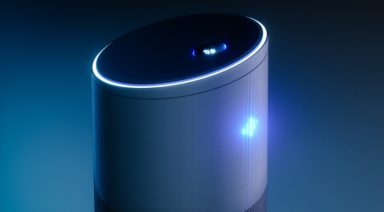NASA Developing Robotic Bees to Collect Samples, Map Mars Surface

NASA’s Mars rovers have gathered a lot of exciting data and photographs, but they’re moving at a snail’s pace. So how will it expedite that process? Robotic bees.
The space agency is developing bee-sized robots to map the surface of Mars and collect samples from the planet’s atmosphere. Scientists hope these insectoids will be more mobile and agile than traditional rovers.
The program, called “Marsbees,” is contracting researchers from the U.S. and Japan to build prototypes of winged robots, capable of swarming the red planet and collecting data, before returning to a rover to recharge.

Image courtesy uah.edu
One of the biggest obstacles engineers face is designing a robot that can fly in Mars’ unique climate. The red planet’s atmosphere can be pretty hostile with dust storms, low thermal inertia, and periodic ice ages. These bees will inevitably face some extreme weather conditions.
But there is one factor that may make the mission easier – Mars’ gravitational pull is about a third of Earth’s, which could prove to be more conducive to flight.
NASA’s website envisions the robots as roughly the size of a bee, but with larger, cicada-sized wings. Researchers imagine the bees will be capable of working independently or in teams to collect samples.
The program funding the project is called the NASA Innovative Advanced Concepts Program, or NIAC, which fosters science fiction concepts with the potential for realistic applications.
The aerial bots would primarily search for methane emissions from below the planet’s surface – an indication of subterranean Martian life. NASA’s Curiosity rover previously discovered low levels of the gas, encouraging scientists to explore further.
But the technology for this apian concept doesn’t have a lot of promising precedent. Several years ago, DARPA built a hummingbird-inspired drone, with a multi-million-dollar budget. Researchers engineered it to fly steadily, but the winged machine would likely struggle in the Martian environment.
Engineers working on the Marsbees prototype will test their robots in a vacuum chamber, with conditions to simulate the climate and air density on Mars. The group is receiving just $125,000 over the course of nine months to fund their prototype, before it will be tested for feasibility by NASA. If it passes preliminary tests, it will then be eligible for a second round of funding.
The Hollow Moon Theory; Is the Moon an Artificial Satellite?

The moon is often described as having divine, feminine energy – the female counterpart to our Sun. It is a source of cosmic phenomena, providing us with beautiful eclipses, changing tides, and hopefully a future staging point for missions to Mars and beyond. But when we start to look at the moon under a closer lens, a number of aberrant characteristics suggest that it might be hollow — and that there may be a secret moon base.
The Moon Rings Like a Bell
The Apollo missions and subsequent moon landings have been at the center of controversy and conspiracy for years. There has been an interminable debate as to whether we actually landed on the moon, what was found there, or to what extent NASA has been hiding information from us. But amid the quarreling and speculation, the number of anomalous features on the moon has puzzled scientists and conspiracy theorists alike.
Toward the latter end of the Apollo missions, NASA astronauts placed seismic recording devices on the lunar surface to document artificial and natural moonquakes. Their equipment recorded activity ranging from meteorite strikes to man-made explosions, and crash landings of Apollo rockets. Even the sun’s heat created seismic activity when it caused the moon to thaw on a daily basis.
The astronauts were given a series of ALSEPs, or Apollo Lunar Surface Experiment Packages to set up seismographs and initiate detonations ranging from shotgun-like charges to mortars with multiple grenades. Eventually, NASA intentionally crash-landed the Apollo 12 module as well as the S-IVB rocket setting off an explosive force equivalent to nearly 12 tons of TNT.





































